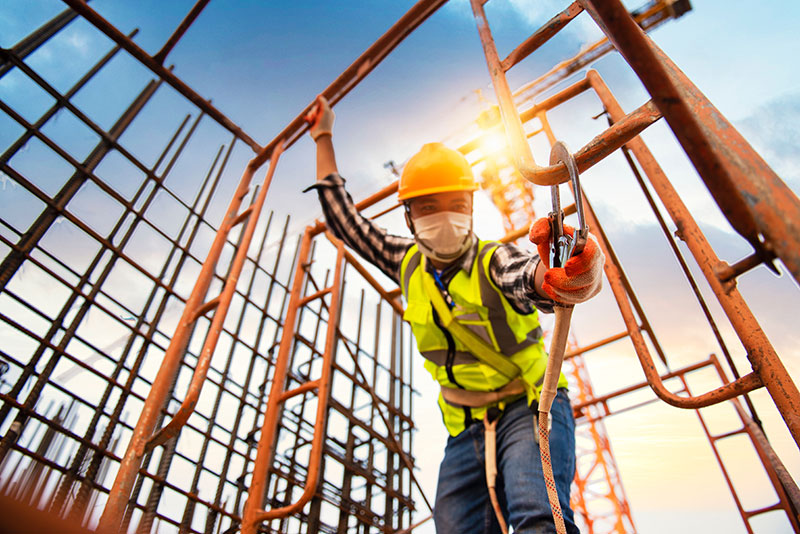Advertisement
Taking care of one’s body is everyone’s responsibility. You rely on your body to function daily and execute your responsibilities. Therefore, caring for it well is paramount. Different people perform various tasks daily, some of which might put their bodies at risk of injuries.
One such activity is working at heights, whether you’re a painter, cleaner, construction worker, etc. You’ll likely slip and fall while performing your job. In some situations, a fall might lead to injuries, including broken limbs. However, you can adopt some practices to ensure your safety as you work at heights. Hence, continue reading to learn the following safety tips:
- Always Wear PPEs
Personal protective equipment (PPE) provides a preventive approach to bodily harm. Thus, you should wear proper PPE when working at heights. In this case, you require a harness, lanyard, helmet, safety shoes, visibility jacket, and guards.
Harness and lanyard work hand in hand to ensure your safety. The harness looks like a vest that crisscrosses to your upper body, with a hook at the front or back where you’ll attach the lanyard. Next, the lanyard is joined to a rope that will hold you in place should you slip and fall, so you’ll hang in the air but not hit the ground. Here, you must ensure the rope is anchored to a strong item that’s steady in position. It shouldn’t slide when you pull at the rope’s end and should handle any weight.
A helmet protects your head should you hit it against a surface or ground during a fall. The elbow and knee guards ensure you don’t break your limbs after a fall. Another PPE you require is a pair of safety shoes that should have an adequate grip to prevent slipping as you work.
Last but not least is the visibility jacket that allows others nearby to see you. If you work alone and get into an accident, people nearby can easily see you and provide you with the necessary assistance.
PPEs must fit you accordingly. If they fail to do so, they’ll barely protect you. For harnesses, invest in adjustable ones that can accommodate different body sizes. You can find various expanded safety harness options from reliable and suitable vendors near you.
- Inspect Your PPEs
Your safety at heights shouldn’t stop with wearing PPE. You want to ensure the PPE is working appropriately to serve you efficiently. Imagine a situation where you slip and fall, and your lanyard is damaged and can’t hold your weight, so you’ll end up hitting the ground and getting injured.
You can prevent such situations by inspecting your PPEs before wearing them to know if it’s damaged. If most of what you do involves working at high heights, consider calling in experts to train your workers on how to do this. After all, it pays to have proper knowledge.
- Use The Right Equipment
It’s said that most accidents at heights occur because of using the wrong equipment for the job. Therefore, you must utilize scaffolds and ladders when necessary.
Scaffolds are ideal if you intend to work for prolonged periods at high heights. Besides their stands, you can place platforms on which your workers can stand as they work. However, you must ensure the scaffold is well erected and made of strong material (e.g., steel). The platforms should also be solid and steady to provide adequate support for your workers. They should hold their weight and the other tools they carry for the job.
Meanwhile, ladders work to give your team access to high heights. However, it’s best not to use the ladder to work for longer periods. As you use a ladder, ensure you support it adequately from the ground. Moreover, lean it against a solid surface and at an angle to prevent the ladder from falling backward as you work.
- Adopt Railings
Railings ensure safety at heights if you have workers on the top floors, such as rooftops or floors with exposed terraces. In such spaces, a small imbalance could lead to catastrophic falls, especially if work is happening at the edges. However, it’s essential to note that you can also adopt railings in your indoor spaces.
Install railings at a considerable height to prevent tipping over. It would help to have the railings up to waist level. Likewise, ensure you adopt both vertical and horizontal rails. For the horizontal ones, ensure you space them in a way that allows workers to work between them. You don’t want them to bend over the rails to work on the edges or adjacent walls.
In addition, be sure that the railings are well anchored to the ground and made of a strong material like steel. You don’t want them to disassemble as your team tries to support itself to prevent falling.
Conclusion

Safety is an aspect you should put at the forefront, especially when working at heights. The tips discussed above have highlighted what you can do to ensure safety when working at heights. Consider adopting them to prevent accidents that come with several negative consequences.

